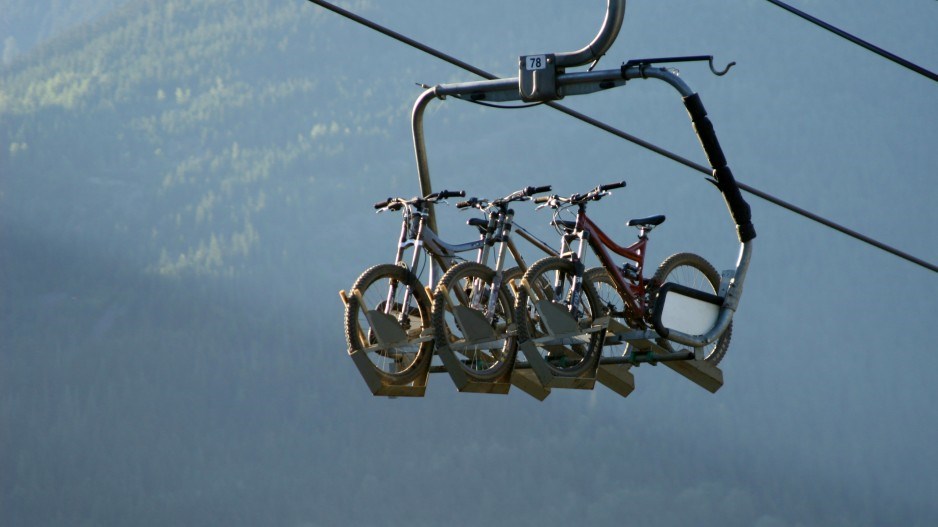Ask any freeride mountain biker what a teeter totter is and you won’t get a description of a toy on a school playground. Along with skinny bridges, fallen rocks, logs and roots, they are emblematic of a type of downhill mountain biking that has become recognized throughout the world as North Shore Style.
Blame the North Shore Mountains, a longstanding destination for mountain bikers. When the sport’s popularity surged in the ’90s, trails proliferated, bicycle makers started building bikes specifically designed for the sport, and riders started showing up at ski resorts, looking for someone to guide them to the mountaintops.
“It started off with guided tours,” said Rob McSkimming, vice-president of business development for Whistler Blackcomb. “The business community wasn’t totally focused on it.”
Their blurred vision didn’t last long. More and more mountain bikers started showing up, pushing the agenda. “It started to make more sense to provide lift access,” said McSkimming.
In 1999 Whistler Blackcomb opened its first bike park, serviced by the Fitzsimmons chairlift. It didn’t hurt that mountain biking was the perfect complement for the resort, which remained relatively quiet once the snow had melted.
“Mountain biking is really the counterpoint to winter, and a big part of the summer scene and culture,” McSkimming said.
In that sense the choice to focus on mountain biking as an industry was an easy decision. The sport had become wildly popular, bicycle manufacturers were building heavier, more durable bikes and the mountains offered some of the best downhill terrain anywhere in the world.
Business boomed. Between June 2006 and September of that year, for example, non-resident visitors to Whistler Bike Park spent an estimated $16.2 million in Whistler, according to a 2006 economic impact study conducted by the Western Canada Mountain Bike Tourism Association.
Whistler Blackcomb invests accordingly, currently budgeting over $200,000 each year on trail building and maintenance alone.
“Whistler Bike Park is by far the most visited lift-access bike park in the world,” McSkimming said.
Whistler Blackcomb has also partnered with bike manufacturer Giant to design and build a line of bicycles specifically for kids, and the resort’s recognition that young riders represent future revenue continues to drive industry development. In 2006 Whistler Blackcomb completed construction on the Airdome, an 8,400-square-foot covered indoor bike training facility with wooden ramps up to 26 feet high and a huge foam pit to cushion the landing.
In 2015, they opened the Creekside gondola to bike access, enhancing access to Whistler Bike Park. The resort plans further expansion at Creekside.
“There’s everything there that you would want,” McSkimming said. “It will become more popular, especially as we build the trail infrastructure. We have some pretty substantial plans there.”
Back in 1999, its first season, Whistler Bike Park counted 11,000 daily visits. By last year that number had ballooned to 160,000, half of whom were destination riders, tourists who had flown in from around the world for the bike park specifically. McSkimming added that riders typically stay at the resort longer than skiers.
Mountain biking’s rise to prominence has followed a path similar to that of golf. In the early ’80s, Whistler Blackcomb was still primarily a ski destination. The resort chose Arnold Palmer’s design company to develop Whistler’s first golf course.
It proved a sound venture, and the club was successful, but the activity had room to grow.
“One golf course does not a golf destination make,” said Alan Kristmanson, general manager at Whistler Golf Club.
So they built three more. Whistler Blackcomb courses now include Whistler Golf Club, Nicklaus North Golf Course, Fairmont Chateau Whistler Golf Club and Big Sky Golf Club in nearby Pemberton. On average, they split 105,000 to 107,000 rounds between them. According to Kristmanson, that’s on par with industry standards for success, which stands at 25,000 to 30,000 rounds per season.
The key to success for the resort has not come from select marketing by individual industry participants, Kristmanson said. He held up the Whistler golf courses as an example.
“We pool our resources, we go to trade shows and market the golf destination of Whistler Blackcomb. We also meet with tour operators from around the world, and we do that as a group.”
The absence of exclusivity extends to activities like mountain biking. Whistler Blackcomb businesses understand that what’s good for one is also good for all. Increased visitor numbers result in higher revenue for not just activities service providers, but apparel shops, restaurants and bars, and hotels too.
“We all understand that this resort is about getting people to Whistler Blackcomb,” he said. “We know people will have a really great experience and will want to come back, and that will benefit us all.”




